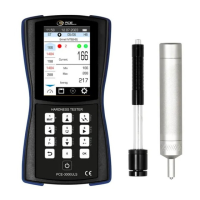16
When control specific samples it is necessary to be guided in addition by paragraph
1.10 "Measurements on light and thin-walled products".
1.10 Measurements on light and thin-walled products
If the controlled product, sample, or measure of hardness does not meet the
requirements of paragraph 1.7 "Requirements for the controlled product" regarding the
weight and/or thickness of the product, the hardness tester will perform measurements with
additional error. The error will be greater than the deviation from these requirements.
In case of the insufficient thickness of the product, the error occurs due to the
"deflection" of the sample at the point of impact of the indenter.
In the case of insufficient mass, the error occurs due to the "displacement" of the
sample from the impact of the indenter.
To determine the presence of additional error, it is necessary to compare the results of
measurements with a hardness tester with the results of measurements with a device of the
stationary principle of operation.
Elimination of additional error on light and thin-walled products
In case of the insufficient thickness of a sample for the elimination of an additional
error, it is necessary to couple a sample to the massive basic flat polished plate.
Recommended hob parameters:
Weight and thickness - greater than the minimum mass and thickness of the controlled
product specified in paragraph 1.7 "Requirements for the controlled product ".
Roughness is minimal. Optimal - no more than Ra 0.4 μm.
Non-flatness is not more than 0.005 mm/0.0002".
The modulus of elasticity of the plate metal (Young's modulus) is close to the modulus
of elasticity of the controlled product.
The lower part of the product must be flat polished. Optimal roughness - no more than
Ra 0,4 microns, no flatness no more than 0,005mm/0.0002".
"Coupling" the product to the surface of the plate through a layer of grease so that there
are no, even small, stains of air layers between the surfaces of the product and the plate. It is
necessary to couple a product densely - that the product and a plate formed a uniform

